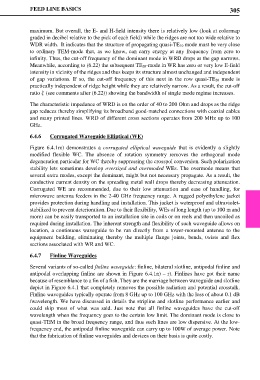Page 325 - Maxwell House
P. 325
FEED LINE BASICS 305
maximum. But overall, the E- and H-field intensity there is relatively low (look at colormap
graded in decibel relative to the pick of each field) while the ridges are not too wide relative to
WDR width. It indicates that the structure of propagating quasi-TE10 mode must be very close
to ordinary TEM-mode that, as we know, can carry energy at any frequency from zero to
infinity. Thus, the cut-off frequency of the dominant mode in WRD drops as the gap narrows.
Meanwhile, according to (6.22) the subsequent TE20-mode in WR has zero or very low E-field
intensity in vicinity of the ridges and thus keeps its structure almost unchanged and independent
of gap variations. If so, the cut-off frequency of this next in the row quasi-TE20 mode is
practically independent of ridge height while they are relatively narrow. As a result, the cut-off
ratio (see comments after (6.22)) showing the bandwidth of single mode regime increases.
The characteristic impedance of WRD is on the order of 40 to 200 Ohm and drops as the ridge
gap reduces thereby simplifying its broadband good-matched connections with coaxial cables
and many printed lines. WRD of different cross sections operates from 200 MHz up to 100
GHz.
6.4.6 Corrugated Waveguide Elliptical (WE)
Figure 6.4.1m) demonstrates a corrugated elliptical waveguide that is evidently a slightly
modified flexible WC. The absence of rotation symmetry removes the orthogonal mode
degeneration particular for WC thereby suppressing the crosspol conversion. Such polarization
stability lets sometimes develop oversized and overmoded WEs. The overmode means that
several extra modes, except the dominant, might but not necessary propagate. As a result, the
conductive current density on the spreading metal wall drops thereby decreasing attenuation.
Corrugated WE are recommended, due to their low attenuation and ease of handling, for
microwave antenna feeders in the 2-40 GHz frequency range. A rugged polyethylene jacket
provides protection during handling and installation. This jacket is waterproof and ultraviolet-
stabilized to prevent deterioration. Due to their flexibility, WEs of long length (up to 100 m and
more) can be easily transported to an installation site in coils or on reels and then uncoiled as
required during installation. The inherent strength and flexibility of such waveguide allows on
location, a continuous waveguide to be run directly from a tower-mounted antenna to the
equipment building, eliminating thereby the multiple flange joints, bends, twists and flex
sections associated with WR and WC.
6.4.7 Finline Waveguides
Several variants of so-called finline waveguide: finline, bilateral slotline, antipodal finline and
antipodal overlapping finline are shown in Figure 6.4.1n) – r). Finlines have got their name
because of resemblance to a fin of a fish. They are the marriage between waveguide and slotline
depict in Figure 6.4.1 that completely removes the possible radiation and potential crosstalk.
Finline waveguides typically operate from 8 GHz up to 100 GHz with the loss of about 0.1 dB
/wavelength. We have discussed in details the stripline and slotline performance earlier and
could skip most of what was said. Just note that all finline waveguides have the cut-off
wavelength when the frequency goes to the certain low limit. The dominant mode is close to
quasi-TEM in the broad frequency range, and thus such lines are low dispersive. At the low-
frequency end, the antipodal finline waveguide can carry up to 100W of average power. Note
that the fabrication of finline waveguides and devices on their basis is quite costly.

